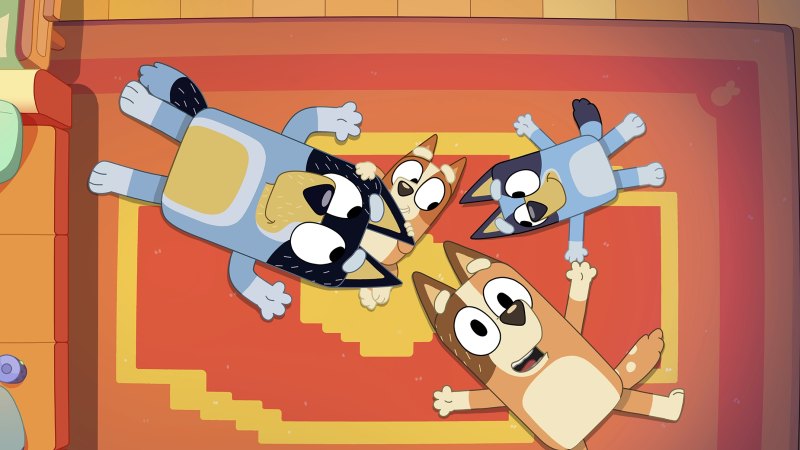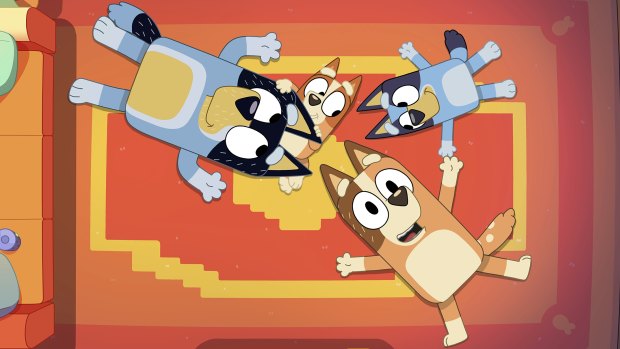Save articles for later
Add articles to your saved list and come back to them any time.
It’s that time of the year when two words strike fear into the hearts of parents who couldn’t papier-mache a boat to save their lives: Book Week.
Last year, during a frenzied costume rush, I found myself embroiled in a debate with my three-year-old about why an Elsa (from Frozen) dress wasn’t appropriate for Book Week. “Look at this!” I said, holding a Snugglepot and Cuddlepie print dress. She looked at me with the kind of ridicule only a three-year-old can muster, and I had flashbacks of my mother trying to buy me “sensible shoes”.
Bluey is one of the most successful Australian TV shows of all time and now an award-winning children’s book series.Credit: ABC
There were tears, a tantrum, and finally, a three-year-old whose dreams came true when she walked into Book Week as Elsa. I felt defeated by commercial forces that were more powerful than my parental guidance.
When Bluey: The Beach, a book based on the storyline of an episode of the TV series, won the Australian Book Industry’s Book of the Year in 2020, it raised all sorts of questions. What is a kid’s book? What should a kid’s book be? Am I a narky purist for turning my nose up at a television franchise winning a literary prize? Is it better for kids to read something over nothing given our nation’s declining literacy rates?
But something about kids rocking up to Book Week in Elsa and Spider-Man costumes really gets my Billy Goat Gruff, even though I know firsthand how hard they are to avoid.
“There’s a quiet frustration among children’s writers who are up against very talented screenwriters whose work is being turned into books,” a children’s writer told me. How is anyone meant to compete against Bluey?
The trend for popular characters across different media to be channelled “into a single commercial system erases the boundaries between primary and secondary texts, enabling primary texts (such as television series and video games) to function as promotional material for other primary texts (such as movies and toys), and vice versa,” Marsha Kinder wrote in Playing with Power in Movies, Television, and Video Games: From Muppet Babies to Teenage Mutant Ninja Turtles.
The commercialisation of stories across mediums leads to never-ending recycling: TV shows become books and multi-instalment movie franchises. Disney films become video games, books, cartoon series, Disneyland rides, toys, T-shirts and costumes that can be pulled out of the dress up box come Book Week.
The marketing machine churns out titles guaranteed to sell, piggybacking on the success of other media or on the names of celebrities or sports icons who have little to do with the book’s actual creation but plenty to do with projected revenue. Even more loathsome are the books created for diversity box-ticking purposes.
It’s not the publishers’ fault that Frozen and Bluey are the equivalent of crack cocaine for small children. But this Book Week, rather than talking about what our kids read, we should be asking why they read.
If Bluey books are the gateway drug that leads kids to other books, this is good. Great, in fact. Countless studies show that the health benefits of reading – whatever the subject – are many.
As adults, we read for various reasons. You might be hooked on elaborate detective novels with dark covers and authors with pseudonyms or prefer psychologically stimulating literature like Liane Moriarty or Sally Hepworth. Maybe you’re a sucker for highbrow literature – the arthouse novel that doesn’t use quotation marks for speech or the Penguin Classics.
In the same way that we have a varied diet in what we eat, we should encourage our children to consume a wide range of literature, too, not just whatever is spewed out of the marketing machine.
Like Guardians of the Galaxy is to a Wes Anderson film, kid’s books also have auteurs: practitioners of style who are passionate about the written form. Think of Graeme Base, Alison Lester, or Jackie French.
More than just encouraging kids to pick up a book – any book – a beautifully crafted story that’s been purpose-made to be read has the power to inspire kids to fall in love with language and the joys of the imagination. TV shows, by contrast, tell you what to look at, with little room for subtlety or personal interpretation. But a good children’s book is like a poem; its meaning won’t reveal itself immediately. You can return to it throughout your life, and it will always whisper new messages. This power is why The Giving Tree and The Velveteen Rabbit still evoke such strong responses in people decades on from their original release.
This Book Week, let your kid wear the Spider-Man outfit but push the boundaries of their reading adventures. I can guarantee you that librarians and local bookshops will be your greatest allies in the mission. The
Marketing is a powerful force, but it has nothing on the imaginations of storytellers whose work continues to speak to us through the ages. And even better, the costumes for these stories can become hand-me-downs.
Cherie Gilmour is a freelance writer.
The Opinion newsletter is a weekly wrap of views that will challenge, champion and inform your own. Sign up here.
Most Viewed in Culture
From our partners
Source: Read Full Article

